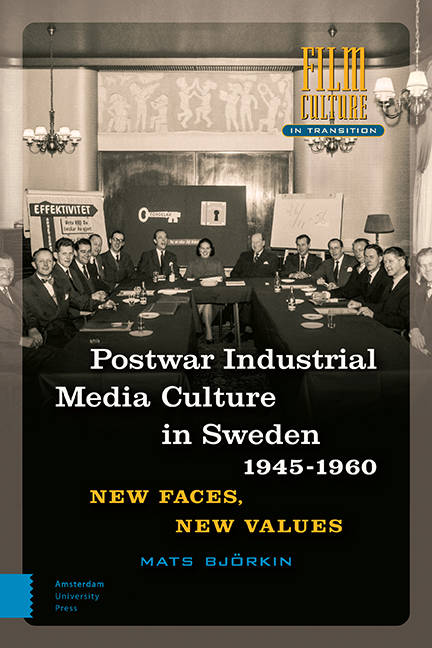Book contents
Intermission: A Substitute for an Industrial Film Theory
Published online by Cambridge University Press: 20 January 2022
Summary
Abstract
The theoretical intermission focuses on how films, slides, sound slides, and flannelgraphs were integrated into organizational and educational contexts, not in the sense of predefined theories, but as an encouragement to create new concepts and practices. One of the main questions concerned the role of human involvement in instructional, educational, and promotional work. These debates coincided with the increasing interest in middle management, particularly the industry foreman.
Keywords: audio-visual tools, pedagogy, interactivity, cybernetics, management
By 1945, industrial films had been produced in Sweden for more than 30 years. Following rapid growth during the mid-1920s, the practice of commissioning industrial films had become common among many larger companies in what were later regarded as the core industries of Sweden: mining, steel, wood, and paper. Industrial films, taking their lead from the dominant industrial-film production company of the 1920s, Tullberg Film, were primarily seen as suitable for public relations and documentation (Björkin 1999). Those interwar period films were made along the lines of the typical nonfiction films of the time, with a straight narrative structure, authoritative narrator (or intertitles), and, in the films of the 1930s and 1940s, dramatic music. Even though they could also be screened at the companies themselves, which they were, they were obviously made as stand-alone aesthetic objects, though with an informational or sometimes even didactic purpose.
During the 1950s, industrial films contributed to shaping the theoretical discussion on corporate communication, organization, corporate learning, human resources, public relations, etc., albeit from the margins. Debates on media effects and agenda setting, however, seemed to be rather absent. Technologies created a bit more than theory could describe uses for, while theory demanded a bit more from technology than it could provide.
It is important, I will argue, to consider the films as the result of the theoretical debates of the time. Industrial films were not only part of developments in corporate communication, organization, and learning, but soon became part of what could be described as a whole system of theories. Or, perhaps more in keeping with its cybernetic foundation, a theory machine, where different technologies, methods, and theories worked together, reacted to each other, and helped each other develop, at least as long as the post-war economic boom continued.
- Type
- Chapter
- Information
- Postwar Industrial Media Culture in Sweden, 1945–1960New Faces, New Values, pp. 99 - 128Publisher: Amsterdam University PressPrint publication year: 2021

